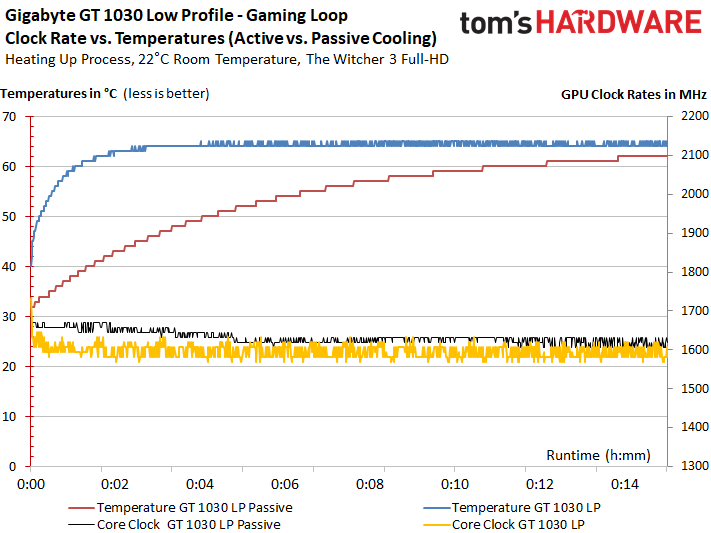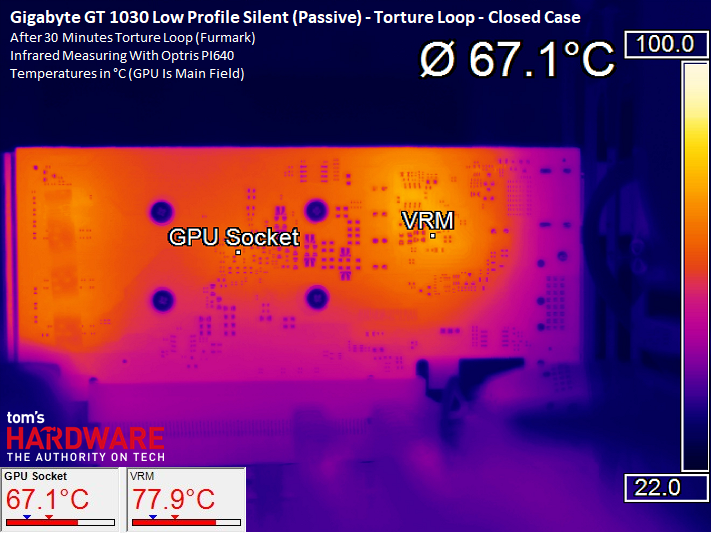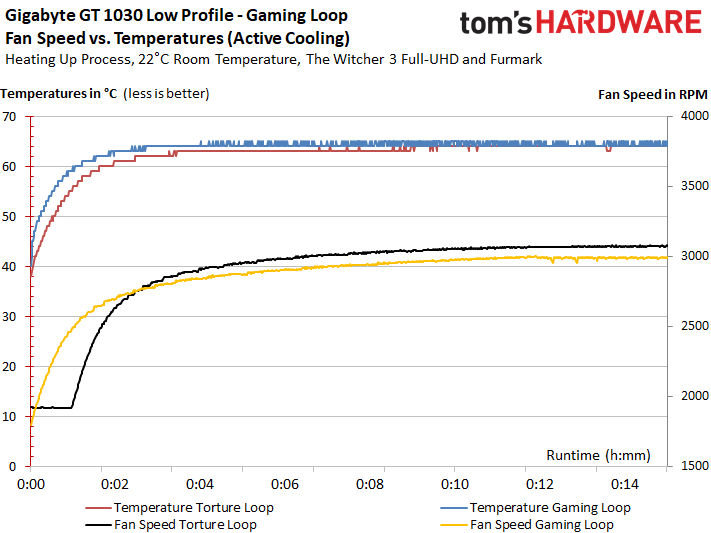Nvidia GeForce GT 1030 2GB Review
Why you can trust Tom's Hardware
Clock Frequency, Temperature & Noise
Temperature & Clock Frequency Curves
The two cards’ warm-up phases couldn’t be more different, but they end up in the same place. Their temperatures never exceed 65 or 66°C.
That latter figure applies to the passive card, which takes a lengthy 24 minutes to get up to temperature. Once it does, the GPUs on both boards hover around the same ~1.6 GHz.
During our stress test, the passive card reaches its final 67°C after approximately 20 minutes. Interestingly, it’s not the GPU that peaks first. Rather, the voltage regulation circuitry gets hotter more quickly, even though the converters get their own cooling from Gigabyte's heat sink.
At 64°C, the active card stays a little cooler due to its fan suddenly accelerating. This is despite the lower frequencies both boards hit under a worst-case load.
Infrared Board Temperature Measurements
Let's look at the actively-cooled card first. During our gaming loop, the VRM reaches almost 86°C. That's not great, but it's still acceptable. The GPU's 65°C is consistent with the card’s temperature target.
During the stress test, current rises along with the fan's rotational speed. This serves to benefit the small GPU's operating temperature, which crests at 64°C.
Unfortunately, the uncooled VRM gets the short end of the stick; we record a temperature peak of 89°C. Gigabyte made the right choice when it chose to implement a second power phase, even if it wasn't necessary from a purely electrical point of view.
Get Tom's Hardware's best news and in-depth reviews, straight to your inbox.
As mentioned, the passive card ends up with a temperature of 66°C. It takes so long to ramp up that our graph ran out of room to show this happening. Temperatures aren't a problem for the GeForce GT 1030 Silent Low Profile 2G, especially since voltage converters stay below 74°C. Direct VRM cooling pays dividends here.
The passive card’s GPU temperature might be 3°C higher during the stress test compared to the version with a fan, but its voltage converters run a massive 11°C cooler.
Somewhat surprisingly, this means that the passively-cooled card achieves better thermal performance.
Fan Speed & Noise
Obviously, we weren't able to measure any noise emanating from the passively-cooled card. Even its two chokes stayed completely silent.
Conversely, the active card’s fan was always in motion. There is no semi-passive mode, so, depending on the workload, the fan spins anywhere from 1800 to 1900 RPM.
Interestingly, the active card’s fan sped up immediately during our gaming loop, but took its time when we applied a stress test. Although we can't explain why, the behavior is reproducible.
There is no spectral analysis for Gigabyte's GeForce GT 1030 Low Profile 2G because the card is so quiet as-is. It'd be hard to generate an analysis of sufficient quality. Due to the lack of a semi-passive mode, the lowest noise level we measured was 28.7 dB(A). This increases to 31.6 dB(A) under full load.
MORE: Best Graphics Cards
MORE: Desktop GPU Performance Hierarchy Table
MORE: All Graphics Content
-
turkey3_scratch This is a fantastic chip! Seeing as it performs nearly on-par with the 750Ti, it has approximately double the performance/power ratio. It is also perfect for a noiseless PC, the passively cooled one is.Reply -
takeshi7 Does this card work with 4K Netflix? From what I've read Nvidia requires 3GB VRAM for it which seems stupid and arbitrary. 2GB is enough to buffer several seconds of 4K movie frames.Reply -
King_V Definitely interesting. Going through the initial tests, I actually started wondering why the RX550 was lower in the hierarchy charts than the 750Ti.Reply
Then, when they switched positions in some other tests, it became more clear. And, I concluded that even putting certain cards in tiers relative to each other is not that easy.
I was very glad to see this test, though, as I'd previously considered getting the GT1030. My need for it is no longer there.
Overall, I think the 750Ti, RX 550, and RX 460 are closer to each other than I anticipated. It does seem the 1030 is behind them all, but not too far behind.
Thanks for this review. I can't wait to see where it ultimately falls in the hierarchy chart(which, oddly, is missing the RX 560 but I suspect that is in the same tier as the RX 460) -
hendriksnyder Will this work with a core I7 7700k? And would it be able to run games like FO4 and TitanFall 2 on ultra settings?Reply -
takeshi7 Reply19934708 said:TAKESHI7
yes it's enough, IDK where you heard that you need 3gb or VRAM.
Multiple sources say you need 3GB VRAM
http://nvidia.custhelp.com/app/answers/detail/a_id/4457/~/preview-of-4k-uhd-netflix-content-on-nvidia-gpus
http://www.pcworld.com/article/3193566/components-graphics/nvidia-quietly-opens-4k-netflix-streaming-on-geforce-gtx-10-series-graphics-cards.html
It's pretty stupid because that means you have to spend twice as much to get a 1050 Ti minimum.
-
zcat Can't wait to swap out my miniITX's old 750Ti with a true successor that's twice as powerful at the same bus-powered max of 60W.Reply -
mikegrok I am going to be installing a bunch of these into a dental office as soon as stocks get better. Dental offices have 2 monitors per computer (usually using the gti 720). One for work, and one to show Netflix, and distract the patients. The computers have CPUs that don't accelerate h265, and the 1000 series nvidia GPUs accelerate the current video codecs.Reply







